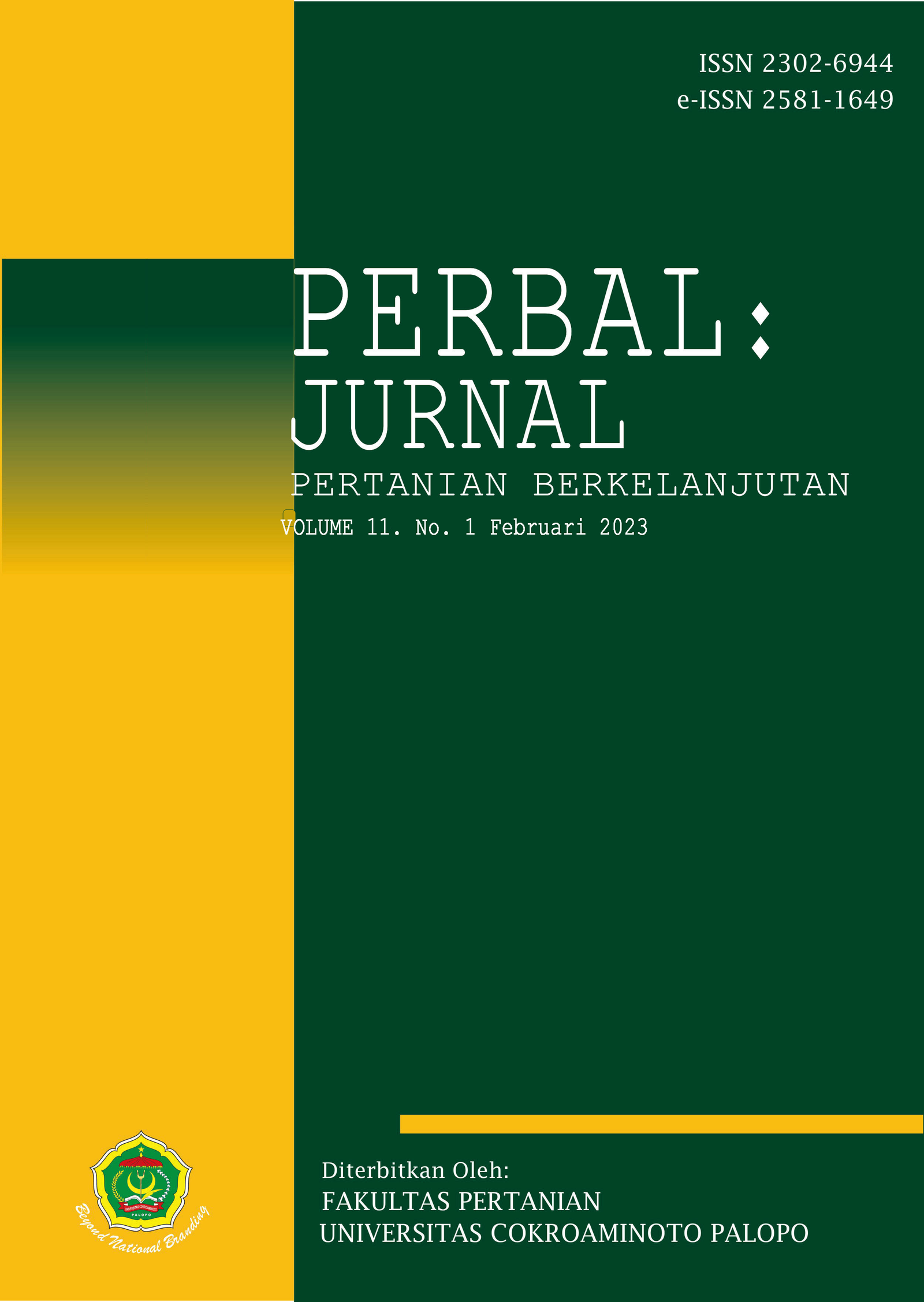Uji Aplikasi Pemberian Air Kelapa Menggunakan Media Arang Kayu Terhadap Pertumbuhan Tanaman Anggrek (Dendrobium sp.) Di Desa Tompobulu Kabupaten Bone
Coconut Water Application Test Using Wood Charcoal Media on Orchid Growth (Dendrobium sp.) in Tompobulu Village, Bone Regency
DOI:
https://doi.org/10.30605/perbal.v11i1.2248Keywords:
anggrek, air kelapa, arang kayu, dendrobiumAbstract
Penelitian ini bertujuan untuk untuk mengetahui respon pemberian air kelapa serta dosis air kelapa yang memberikan pengaruh terbaik terhadap pertumbuhan tanaman anggrek dendrobium. Penelitian ini dilaksanakan di Desa Tompobulu, Kecamatan Libureng Kabupaten Bone. Penelitian ini mengunakan Rancangan Acak Kelompok (RAK) yang terdiri atas 4 Perlakuan dan 3 ulangan, sehingga terdapat 12 unit percobaan. Perlakuan yang digunakan yaitu P0 = tanpa perlakuan (kontrol), P1 = pemberian air kelapa100 ml/tanaman, P2 = pemberian air kelapa150 ml/tanaman, P3 = pemberian air kelapa 200 ml/tanaman. Hasil penelitian menunjukkan bahwa pemberian air kelapa tidak berpengaruh nyata untuk parameter tinggi tanaman, panjang daun, lebar daun dan jumlah daun. Hal ini sebabkan karena proses penyerapan unsur hara lambat dan faktor lingkungan sehingga tidak memberikan pengaruh yang nyata terhadap pertumbuhan tanaman anggrek. Perlakuan P0 menghasilkan tinggi tanaman terbaik dengan rata-rata 15.73 cm, perlakuan P2 menghasilkan panjang daun terbaik dengan rata-rata 14.19 cm, dan untuk lebar yang terbaik pada perlakuan P2 dengan rata-rata 3.50 cm sedangkan untuk perlakuan P3 menghasilkan jumlah daun terbaik dengan rata-rata 5 helai.
This study aims to determine the response to coconut water and the dose of coconut water which has the best effect on the growth of dendrobium orchid plants. This research was conducted in Tompobulu Village, Libureng District, Bone Regency. This study used a randomized block design (RBD) consisting of 4 treatments and 3 replications, so there were 12 experimental units. The treatment used was P0 = no treatment (control), P1 = giving coconut water 100 ml/plant, P2 = giving coconut water 150 ml/plant, P3 = giving coconut water 200 ml/plant. The results showed that the administration of coconut water had no significant effect on the parameters of plant height, leaf length, leaf width and number of leaves. This is due to the slow absorption of nutrients and environmental factors that do not have a significant effect on the growth of orchid plants. Treatment P0 produced the best plant height with an average of 15.73 cm, treatment P2 produced the best leaf length with an average of 14.19 cm, and for the best width in treatment P2 with an average of 3.50 cm while for treatment P3 produced the best number of leaves with an average - average 5 strands.
Downloads
References
Abidin dan Bey. (2006). Budidaya Anggrek. Agro Media Pustaka. Depok.
Aeni, S. N. (2022). Cara Menanam Anggrek dengan Arang, Mudah dan Praktis. Kompas. Diakses 15 Oktober 2022.
Astuti, P. (2010). Zat Pengatur Tumbuh. Agro Media Pustaka. Jakarta.
Awaluddin. (2016). Struktur dan Fungsi Daun. Insitut Teknologi Bandung.
BPS. (2021). Produksi Tanaman Florikultura (Hias) 2020. Https://www.bps.go.id. Diakses tanggal 10 Oktober 2022.
Dwidjoseputro. (1994). Pengantar Fisiologi Tumbuhan. Gramedia Pustaka. Jakarta.
Ekawati dan Engestald. (2006). Pengolahan Arang dan Kegunaannya. Agro Industri Press. Bogor.
Lakitan. (1996). Pengaruh Intensitas Cahaya Terhadap Pertumbuhan Tanaman Anggrek. Jurnal Hortikultura. Bandung. 45 hal.
Nesiaty, S., dan Maloedyn, S. (2007). Kiat Sukses Membungakan Anggrek. Agro Media Pustaka. Jakarta.
Sandra. (2001). Membuat Anggrek Rajin Berbunga. Agromedia Pustaka. Jakarta.
Syarif. (1986). Prosedur Statistik Penelitian Pertanian. Universitas Indonesia. Jakarta.
Seswita, D. (2010). Penggunaan air kelapa sebagai zat pengatur tumbuh pada multiplikasi tunas temulawak (Curcuma xanthorriza Roxb.) secara in vitro. J. Littri 16 (4): 135-140. DOI: https://doi.org/10.21082/jlittri.v16n4.2010.135-140
Supari. (1999). Budidaya Anggrek Bulan. Kanisius. Yogyakarta. 76 hal 25.
Vigliar, R., Sdepanian, V. L. & Fagundes-Neto, U. (2006). Biochemical profile of. coconut water from coconut palms planted in an Inland Region. J. de Pediatria. Vol: 82 (4): 308-312. DOI: https://doi.org/10.2223/JPED.1508
Widiastoety, D, dan Purbadi. (2003). Pengaruh Bubur Ubi kayu dan Ubi jalar terhadap Pertumbuhan Plantlet Anggrek Dendrobium. J.Hort. Vol. 13 (1) 2003 : 1 – 6.
Yusnida, B. (2006). Pengaruh pemberian Giberelin (GA3) dan air kelapa terhadap perkcembahan bahan biji anggrek bulan (Phalaenopsis Amabilis bl ) secara Invitro . Jurnal Hayati Vol 2 No.2 :41-46.
Downloads
Published
Issue
Section
License
In submitting the manuscript to the journal, the authors certify that:
- They are authorized by their co-authors to enter into these arrangements.
- The work described has not been formally published before, except in the form of an abstract or as part of a published lecture, review, thesis, or overlay journal.
- That it is not under consideration for publication elsewhere,
- That its publication has been approved by all the author(s) and by the responsible authorities – tacitly or explicitly – of the institutes where the work has been carried out.
- They secure the right to reproduce any material that has already been published or copyrighted elsewhere.
- They agree to the following license and copyright agreement.
License and Copyright Agreement
Authors who publish with Onoma Journal: Education, Languages??, and Literature agree to the following terms:
- Authors retain copyright and grant the journal right of first publication with the work simultaneously licensed under Creative Commons Attribution License (CC BY 4.0) that allows others to share the work with an acknowledgment of the work's authorship and initial publication in this journal.
- Authors are able to enter into separate, additional contractual arrangements for the non-exclusive distribution of the journal's published version of the work (e.g., post it to an institutional repository or publish it in a book), with an acknowledgment of its initial publication in this journal.
- Authors are permitted and encouraged to post their work online (e.g., in institutional repositories or on their website) prior to and during the submission process, as it can lead to productive exchanges, as well as earlier and greater citation of published work.

